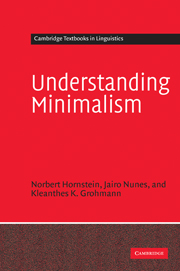Book contents
- Frontmatter
- Contents
- Preface
- List of abbreviations
- 1 The minimalist project
- 2 Some architectural issues in a minimalist setting
- 3 Theta domains
- 4 Case domains
- 5 Movement and minimality effects
- 6 Phrase structure
- 7 Linearization
- 8 Binding Theory
- 9 Feature interpretability and feature checking
- 10 Derivational economy
- Glossary of minimalist definitions
- References
- Language index
- Name index
- Subject index
5 - Movement and minimality effects
Published online by Cambridge University Press: 05 June 2012
- Frontmatter
- Contents
- Preface
- List of abbreviations
- 1 The minimalist project
- 2 Some architectural issues in a minimalist setting
- 3 Theta domains
- 4 Case domains
- 5 Movement and minimality effects
- 6 Phrase structure
- 7 Linearization
- 8 Binding Theory
- 9 Feature interpretability and feature checking
- 10 Derivational economy
- Glossary of minimalist definitions
- References
- Language index
- Name index
- Subject index
Summary
Introduction
In chapter 3 we examined the reasoning that points to the conclusion that arguments are θ-marked within a lexical projection. In particular, we discussed several pieces of evidence for the Predicate-Internal Subject Hypothesis (PISH), according to which external arguments are θ-marked within a verbal projection. Under the PISH, he in (1), for instance, receives its θ-role when it merges with V′ or v′, depending on whether one assumes a single VP-shell or a double VP-shell involving a light verb v (see section 3.3), as respectively shown in (2).
(1) He greeted her.
(2) a. he + Merge [V′ greeted her] →
[VP he [V′ greeted her]]
b. he + Merge [v′v [VP greeted her]] →
[vP he [v′v [VP greeted her]]]
In chapter 4, in turn, we discussed conceptual and empirical arguments for the proposal that by LF, DPs must uniformly check their structural Case requirements outside the domains where they are θ-marked. More specifically, we discussed two possible scenarios depending on the choice between the theoretical possibilities in (2), as respectively illustrated in the simplified representations in (3).
Under the single-VP-shell approach sketched in (3a), the subject argument moves to [Spec,AgrSP] at some point in the derivation to check its nominative Case, and the object moves to [Spec,AgrOP] to check its accusative Case.
- Type
- Chapter
- Information
- Understanding Minimalism , pp. 141 - 173Publisher: Cambridge University PressPrint publication year: 2005



